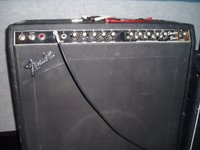Back to Bassics
It seems my ego know no bounds. I am referring to a previous post in which I commented "With this setup, I am quietly confident in the bass sound being large." Well I was right about one thing, it just so happens that it wasn't about the setup. It turns out that that only way I could record using an Ampeg classic bass head was if I shelled out 3500 bucks to the kind people at John Reynolds. Whilst they are kind, they bungled up, one person tell me it was for hire, and another trying to convince me it was the deal of the century, meanwhile I don't even play bass! I ended up visiting my friends at Rock Music on Pultney St and trying out a few amps myself. It all came down to 2 amps in the end, and it was a case of transistor vs tube. The amps in question were the Ampeg SVT-4 Pro and the Fender Studio Bass. Now when I say transistor, I am referring to the Ampeg, as it uses MOSFET power amps. MOSFET is acronym for metal oxide semiconductor field-effect transistor. Without giving you a complete technical rundown I will note that MOSFETs are commonly found in computer chips and are actually not metal but silicone. The advantage of using MOSFETs for power applications is that they deliver transistor equivalent power levels, whilst behave similar to vaccum tube. The idea is create an amplifier which has high power capabilities (the SVT-4 delivers a staggering 1200w into 4ohms!) with the extra warmth synonymous with tube driven amps.I tried out the SVT-4 Pro through a Hartke 4x10 cab using a Fender Jazz bass. The sound was quite harsh with loads of attack in the top end which I attributed to the Hartke cab due to its aluminumium cones. Revelation time; paper cones! Out with the Hartke in with the Ampeg 4x10 cab. Much better. The SVT-4 comes with a variable 0-7:1 compressor, quite handy for the style of bass I was planning to record; 4 string detuned to a low A can produce a large dynamic range particularly with the top end twang.
 The Fender Studio Bass amp is on the other side of the spectrum to the ultra modern SVT-4. All valve pre and power amps this vintage baby was made in 1978. The 200 watt Fender was originally designed as a combo with a 15" speaker, however the old warhorse I was using had the speaker kicked in. Looks can be deceiving though, the Fender had been recently reconditioned with a brand new set of 6 6L6's installed. That amp sounds amazing. Clean and crisp at low volume, warm and overdriven when cranked, breaking up nicely with an aggressive playing style. Whilst the Ampeg is a quality amp with many modern features, I could not look past the Fender with its rich vintage tone. The Fender is the choice for this recording.
The Fender Studio Bass amp is on the other side of the spectrum to the ultra modern SVT-4. All valve pre and power amps this vintage baby was made in 1978. The 200 watt Fender was originally designed as a combo with a 15" speaker, however the old warhorse I was using had the speaker kicked in. Looks can be deceiving though, the Fender had been recently reconditioned with a brand new set of 6 6L6's installed. That amp sounds amazing. Clean and crisp at low volume, warm and overdriven when cranked, breaking up nicely with an aggressive playing style. Whilst the Ampeg is a quality amp with many modern features, I could not look past the Fender with its rich vintage tone. The Fender is the choice for this recording.



